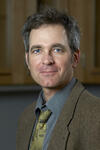In The News: School of Life Sciences

Sabertooth cats once roamed Las Vegas, mammoths towered over the valley, and now, you can see them.

For eons humans have gazed into the heavens and pondered the mysteries of the universe.

In Northern Nevada’s Great Boiling Spring, strange microscopic creatures thrive in water hot enough to kill you.

Tracing your family roots. It's research that can turn up all kinds of surprises, and maybe even links to famous ancestors.
It’s a beekeeper’s nightmare: She lifts the lid on her carefully tended hive and is greeted with a whiff of rotting flesh. Further inspection finds that the young bees of the colony, who should be plump, pearly-white larvae, have melted into a puddle of brownish goo at the bottom of their cells. This colony is infected with American foulbrood disease—most likely a death sentence.
Scott Abella began researching changes in plant life in the Oak Openings in 2002 as an undergraduate intern from Grand Valley State University in Michigan. Fifteen years later, Dr. Abella, assistant professor in the School of Life Sciences at the University of Nevada, Las Vegas, continues his research on his summer breaks.
Biologist Allen Gibbs calls them his “all-American flies.”

Say the word "virus" and most people think of disease -- something to be avoided at all costs. However, at UNLV, students are getting their hands dirty to discover something that could keep us healthy.
Inside a lab on the fourth floor of the Science and Engineering Building at the University of Nevada, Las Vegas, Ka-Voka Jackson pulled from a brown sack a dried seed head of the invasive plant called ravennagrass. She slowly maneuvered the brittle branch out, and from its wispy ventricles tiny seeds poofed into the air, across the counter and onto the floor. A couple of them latched onto her long black hair. “Each of the seed stock plumes can produce thousands per plant,” she said, as she shimmied it back into the bag. “It’s a prolific seed bearer. They are very light, and they can travel by wind, float on the water. And it seems to spread very efficiently in this area.”
In his recent trip to Nevada, Interior Secretary Ryan Zinke spent a few hours in one of our newest national monuments — Gold Butte, where he viewed Native American rock art threatened by vandals, hiking trails that offer countless opportunities for exploration and fragile desert plants and wildlife native to only this region.

If fishing reports existed 250 million years ago they probably would have warned anglers to bring extra sturdy line to northern Nevada. That’s because newly described fossil evidence shows the warm waters of the time were home to a toothy apex predator that chomped its prey like a modern shark.
In a 2016 interview with CNN, Anthony Scaramucci — President Donald Trump's new White House communications director — said that Earth, as well as human history, is just 5,500 years old. But ample evidence exists to prove that the world has been around for much, much longer.





